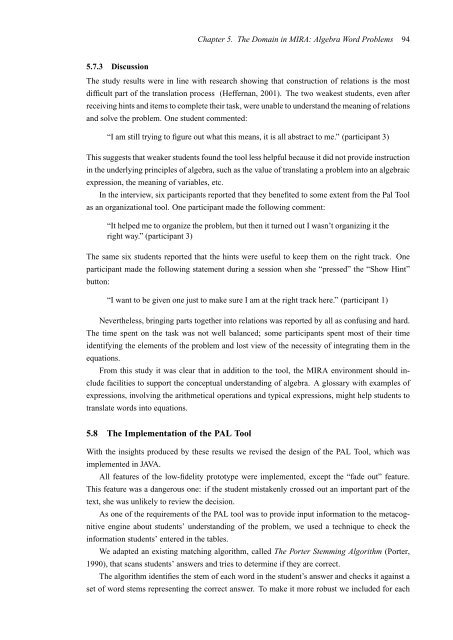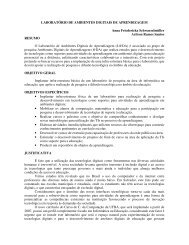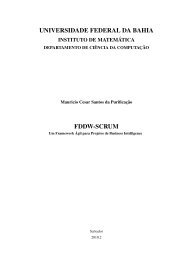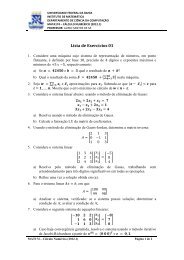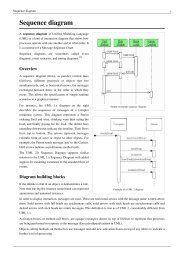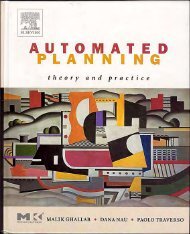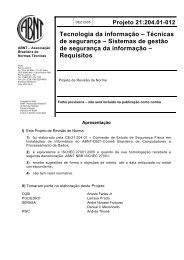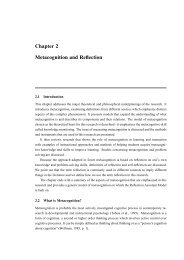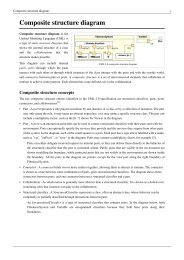Chapter 5 The Domain in MIRA: Algebra Word Problems
Chapter 5 The Domain in MIRA: Algebra Word Problems
Chapter 5 The Domain in MIRA: Algebra Word Problems
Create successful ePaper yourself
Turn your PDF publications into a flip-book with our unique Google optimized e-Paper software.
<strong>Chapter</strong> 5. <strong>The</strong> <strong>Doma<strong>in</strong></strong> <strong>in</strong> <strong>MIRA</strong>: <strong>Algebra</strong> <strong>Word</strong> <strong>Problems</strong> 945.7.3 Discussion<strong>The</strong> study results were <strong>in</strong> l<strong>in</strong>e with research show<strong>in</strong>g that construction of relations is the mostdifficult part of the translation process (Heffernan, 2001). <strong>The</strong> two weakest students, even afterreceiv<strong>in</strong>g h<strong>in</strong>ts and items to complete their task, were unable to understand the mean<strong>in</strong>g of relationsand solve the problem. One student commented:“I am still try<strong>in</strong>g to figure out what this means, it is all abstract to me.” (participant 3)This suggests that weaker students found the tool less helpful because it did not provide <strong>in</strong>struction<strong>in</strong> the underly<strong>in</strong>g pr<strong>in</strong>ciples of algebra, such as the value of translat<strong>in</strong>g a problem <strong>in</strong>to an algebraicexpression, the mean<strong>in</strong>g of variables, etc.In the <strong>in</strong>terview, six participants reported that they benefited to some extent from the Pal Toolas an organizational tool. One participant made the follow<strong>in</strong>g comment:“It helped me to organize the problem, but then it turned out I wasn’t organiz<strong>in</strong>g it theright way.” (participant 3)<strong>The</strong> same six students reported that the h<strong>in</strong>ts were useful to keep them on the right track. Oneparticipant made the follow<strong>in</strong>g statement dur<strong>in</strong>g a session when she “pressed” the “Show H<strong>in</strong>t”button:“I want to be given one just to make sure I am at the right track here.” (participant 1)Nevertheless, br<strong>in</strong>g<strong>in</strong>g parts together <strong>in</strong>to relations was reported by all as confus<strong>in</strong>g and hard.<strong>The</strong> time spent on the task was not well balanced; some participants spent most of their timeidentify<strong>in</strong>g the elements of the problem and lost view of the necessity of <strong>in</strong>tegrat<strong>in</strong>g them <strong>in</strong> theequations.From this study it was clear that <strong>in</strong> addition to the tool, the <strong>MIRA</strong> environment should <strong>in</strong>cludefacilities to support the conceptual understand<strong>in</strong>g of algebra. A glossary with examples ofexpressions, <strong>in</strong>volv<strong>in</strong>g the arithmetical operations and typical expressions, might help students totranslate words <strong>in</strong>to equations.5.8 <strong>The</strong> Implementation of the PAL ToolWith the <strong>in</strong>sights produced by these results we revised the design of the PAL Tool, which wasimplemented <strong>in</strong> JAVA.All features of the low-fidelity prototype were implemented, except the “fade out” feature.This feature was a dangerous one: if the student mistakenly crossed out an important part of thetext, she was unlikely to review the decision.As one of the requirements of the PAL tool was to provide <strong>in</strong>put <strong>in</strong>formation to the metacognitiveeng<strong>in</strong>e about students’ understand<strong>in</strong>g of the problem, we used a technique to check the<strong>in</strong>formation students’ entered <strong>in</strong> the tables.We adapted an exist<strong>in</strong>g match<strong>in</strong>g algorithm, called <strong>The</strong> Porter Stemm<strong>in</strong>g Algorithm (Porter,1990), that scans students’ answers and tries to determ<strong>in</strong>e if they are correct.<strong>The</strong> algorithm identifies the stem of each word <strong>in</strong> the student’s answer and checks it aga<strong>in</strong>st aset of word stems represent<strong>in</strong>g the correct answer. To make it more robust we <strong>in</strong>cluded for each


